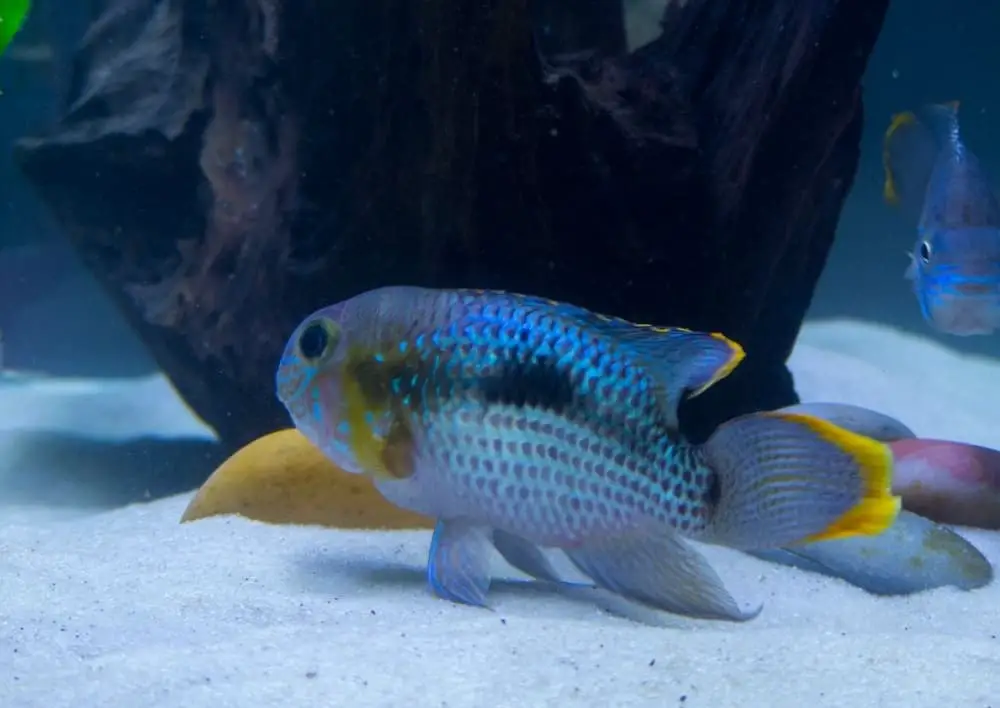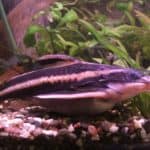It’s perhaps unfair to call this South American cichlid the “Green Terror” – after all, it isn’t always green. The aggressive behavior is certainly a defining feature of this remarkable cichlid, although “Terror” might be taking it too far. An inquisitive nature combined with a large tank can soften out those territorial edges.
Found in the freshwater of Peru and Ecuador, the Green Terror is a member of the cichlid family. Although aggression is common, the gorgeous coloring makes them a popular choice for a home aquarium.

If you’re thinking of owning a Green Terror, then this guide tells you everything you need to know.
Care Guide
Tank Size
A 35 gallon tank is the minimum size for keeping a Green Terror Cichlid. Ideally, a single fish will be kept in a 50 gallon tank.
If you intend to keep a pair, a 75 gallon tank is the minimum. As a rule, an extra 35 gallons should be added to the tank size for each new fish. This allows the Green Terror to establish a territory, and reduce aggression.
The larger tank is not only better for the fish, it’s better for the owner as well. A big tank can reduce the aggressive behavior of the Green Terror, as they don’t feel as compelled to defend territory. They’re also a curious fish, and a larger tank gives them more room to explore, which is very satisfying to watch.
Tank Mates
Green Terrors can have tank mates, but they should be fish of a similar size with a bold temperament. Larger fish also make a good choice. Other large cichlids, such as the Fire Mouth Cichlid or Jack Dempseys, can be good tank mates for the Green Terror.
Larger species that can live with the Green Terror include Tetras, Plecs, Gars, and Silver Dollars.
Small fish are at risk of being eaten by the Green Terror, or being bullied. Shy fish also risk the aggression of the Green Terror.
If you do want to have a mixed species tank, then it needs to be a large tank. This gives the Green Terror a chance to establish its own territory.
Same Species Tanks
It is possible to keep Green Terrors in a same species tank, but the tank size will need to increase to accommodate the additions. Also, adding rocks and driftwood can help the Green Terror to set perimeters around territory, which reduces aggression.
Paired Green Terrors are good at sharing a tank, as they often mate for life. Again, a large tank is best, but the breeding pair should be happy with cohabitation.
Water Parameters
As a hardy fish, the Green Terror can deal with a reasonable range of water parameters. Warm water is necessary to mimic the natural environment of South America. Between 68 and 77 F is recommended (20-25 C). Water hardness must be between 5 – 20 dGH, with a pH level of 6.5 – 8.0.
Although anywhere within these conditions is acceptable, the Green Terror is very sensitive to change. It’s important to monitor the water conditions, and keep everything steady. Poor water can lead to disease, and significantly affect the lifespan of the Green Terror.
Partial water changes are recommended. A 20% change every two weeks is considered ideal.
What To Put In Their Tank
The Green Terror Cichlid likes some decorations. A sandy substrate is necessary, as the Green Terror, like other cichlids, likes to dig. Avoid a gravel substrate, as Green Terrors can try to eat the gravel, leading to injury.
As they’re diggers, it’s important to be careful with any plant life. Floating plants are best, because the Green Terror can’t uproot them.
Decorate the tank with rocks and driftwood. These give the Green Terror a place to shelter, and also provide shade. Decorations are particularly important in a shared tank, as they can act as boundaries when establishing territory.
A mixture of caves and free space should keep the Green Terror happy. They like room to swim, and don’t confine themselves to any one part of the tank.
Green Terrors don’t like particularly bright lights. Keep the tank in a shaded area, and use rocks and caves so they have a place to hide.
Common Diseases
A hardy fish, the Green Terror is still susceptible to some diseases. It particularly struggles with infection, which are often caused by fluctuating water conditions. HLLE, or Head and Lateral Line Erosion, causes a deterioration of the flesh. It’s thought to be caused by sustained exposure to water that’s too hard.
Green Terror Cichlids are also predisposed to lymphocystis disease. This is a viral disease, which is often caused by stress, and leads to white lesions on the fins and skin.
The best way to prevent disease in the Green Terror is to take care with the water conditions.
Food & Diet
In the wild, the Green Terror is largely carnivorous. However, it’s also an opportunistic feeder. Kept in an aquarium, a Green Terror will enjoy an omnivorous diet, with plenty of variety.
A mixture of live food, frozen food, and pellets is good for the Green Terror. Shrimp, earthworms, and mussel meat can all form part of the diet. Even crickets and tube worms will be enjoyed. Live food is best, but frozen works as well. Supplement the meaty diet with pellets and flakes.
Overeating is a problem for the Green Terror Cichlid. Only feed them twice a day, and only give them what can be eaten in a couple of minutes.
Lifespan
Green Terrors are not short term fish. The expected lifespan is 7-10 years. Monitoring the water conditions, and a good diet, is the key to a long life.
Appearance
The delightful appearance of the Green Terror is one of the reasons it’s become such a popular fish for the aquarium. Despite what the name suggests, they aren’t always green.
Instead, the body may be a vibrant green or blue, decorated with bright blue stripes on the face and body. They also have a vivid orange strip along the fins, although this can be missing in the female.
The Green Terror has a prominent forehead, with long and flowing fins. It’s definitely an eye-catching fish, and a beautiful addition to any tank.
Size
Male can reach 12 inches (30 cm), even in an aquarium. However, they’re more likely to be between 6 and 8 inches (15 to 20 cm).
Behavior & Temperament
It’s probably not a surprise to learn that this can be a particularly aggressive species of fish – it really does live up to the “terror” in its name. They’re known for being violent towards other small fish, and will often become more aggressive as they age.
Even though they’re aggressive, the Green Terror is still a lovely fish to own. They’re intelligent and inquisitive, and will explore every part of the tank. If you aren’t careful, it’s easy to lose several hours watching this beautiful fish move through the water.
Breeding
Breeding Green Terrors is a relatively easy process. Once paired, they tend to stay together for life. You can purchase an already established pair, or buy several young Green Terrors, and have them naturally pair off.
If you’re keeping your breeding pair in a tank with other fish, then they need to be separated. They become particularly aggressive when mating.
When ready for breeding, the colors of the Green Terror become more vibrant. The male may also develop a hump on the forehead (although in tank fish this is often present at all times).
Raising the tank temperature slightly, to around 77-80F (25-26.7 C), can encourage breeding. The fish will begin to prepare the tank for egg laying. They may clean the sand off a section of the glass, or clean the surface of a flat rock.
The female will lay 400-600 eggs, with the male following behind to fertilize them. Small and yellow, it takes 3 to 4 days for the eggs to hatch. The fry will be free swimming in around 10 days. Feed them brine shrimp, or specially formulated fry food.
The adults should be kept with the fry, as they’re surprisingly good parents. If separated, the male may try to breed the female again, and become incredibly aggressive.
Gender Differences: Male vs Female
There are some significant differences between the male and female Green Terror Cichlid. The males are often significantly larger than the females. They also develop a pronounced bump on the forehead. Although this is most prominent during breeding, in a tank environment this bump can be permanent.
Females are often darker and duller in color, and can lack the distinctive orange stripe.
Fun Facts
- First time fish owners may find the Green Terror to be a bit of a handful. Due to the importance of steady water conditions, this cichlid is only recommended for owners with experience.
- The Green Terror cichlid is a benthopelagic fish, meaning it loves to explore different depths. One minute it will be swimming with the bottom feeders, and the next second it’s searching the top of the tank for food.








